Senate Republicans’ aggressive slowdown in judicial confirmations so far in 2015—and what is likely to be a continued slowdown through 2016—are contrary to the confirmation records in the final two years of the other two-term presidencies since 1961—Ronald Reagan, William Clinton, and George W. Bush.
In their final two years, the Senate confirmed:
- a fifth or more of their total eight-year appointees;
- substantial minorities of those two-year totals by mid-September of the seventh year; and
- at a fairly robust pace until the second half of the eighth year, when it slowed down but hardly stopped.
Like President Obama, those presidents submitted nominations to a Senate controlled by the other party. In each of those president’s final two years in office, the Senate confirmed a fifth or more of their full eight-year complement of district and circuit judges.
 The Senate confirmed substantial minorities of those two-year totals by mid-September of the seventh year. The six 2015 confirmations from January to mid September 2015 compare poorly to the 23 at the same point in 1987, to the 17 in 1999, and to the 29 in 2007.
The Senate confirmed substantial minorities of those two-year totals by mid-September of the seventh year. The six 2015 confirmations from January to mid September 2015 compare poorly to the 23 at the same point in 1987, to the 17 in 1999, and to the 29 in 2007.
The Senate confirmed a quarter or more of the earlier presidents’ final two year confirmations in January to mid September of the seventh year—28 percent of Reagan’s, 23 percent of Clinton’s, and a much higher 43 percent of Bush’s.
Measured differently, Reagan’s 23 confirmations from January to mid- September 1987 increased his total confirmations to that point by eight percent, Clinton’s by six percent, Bush’s by 12 percent—but Obama’s by only two percent.

Senate Judiciary Chair Charles Grassley claimed that, had the Senate confirmed in 2015 the 11 judges confirmed late in 2014 (without opposition), it would be on “roughly the same pace” in 2015 as it was in 2007: That doesn’t square with either the metric of percentage increase over the first of the year (six percent versus 12 percent) or with the number of confirmations (17 versus 30). And it’s only tangentially relevant. The best measure of Senate effectiveness in confirmations is a reduction in vacancies, which rose in 2015 from 40 to 63, January to mid-September, but dropped from 53 to 46 in the corresponding period in 2007.
This year’s slowdown is due (see my recent post) in part to this Senate’s reluctance to confirm Obama nominees and in part to the dearth of nominations, an apparent result in part of home-state Republican senators’ using their virtual veto over nominees to prevent submissions (somewhat as did Democratic senators in the Bush administration).
In the three earlier periods, the Senate confirmations were fairly robust until the second half of the eighth year, when the pace slowed down but hardly stopped. The scant number of 2015 confirmations so far suggests that confirmations henceforth will need to be at a much quickened pace for Obama to match his predecessors’ overall records, and more important, to reduce the number of vacancies or at least prevent even more increases.
It’s hard to read the tea leaves on whether nominations and confirmations will pick up. For example, of the 30 nominee-less district vacancies, seven are in Texas with a median age of 20 months. On August 31, Senators Cornyn and Cruz invited applicants for two of the seven. A cynic might wonder if this action was mainly for show. The senators’ professed hope to “fill these openings as soon as possible” seems at odds with the age of the vacancies—one in East Texas, where the oldest vacancy was announced in March 2014, and one in Southern Texas, where the oldest vacancy was announced in July 2010. Furthermore, the October 13 deadline for submitting applications to the senators’ vetting committee merely starts the process of vetting, settling on prospective nominees to propose to the White House, negotiations with the White House, administration vetting, and perhaps nomination. It’s hard to believe that either vacancy would see a nominee before 2016.
And confirmations may increase, at least in some states —beyond the expected approval of Senator Grassley’s two pick for Iowa vacancies. For example, Senator Toomey of Pennsylvania, in announcing his reelection bid, stressed his bipartisanship in securing confirmations. “[I]n the four and a half or so years I’ve been in the Senate, [he and Democratic Senator Casey] have been able to recruit, vet, nominate, confirm 15 men and women across the commonwealth of Pennsylvania.” Toomey “looked forward” to confirmation of four Pennsylvania district nominees who went to the Senate just prior to the August recess. They are for vacancies that are all two years or older.
In any event, Senate actions in 1987-88, 1999-2000, and 2007-08 offer solid precedent for a robust confirmation pace through Autumn of 2016. As shown below, the Senate confirmed from over a fifth to over two-fifths of all final-year confirmations in the first half of the eighth year and a little over a tenth to a fifth after July of that year, reducing vacancies in two instances and holding them about steady in the other.
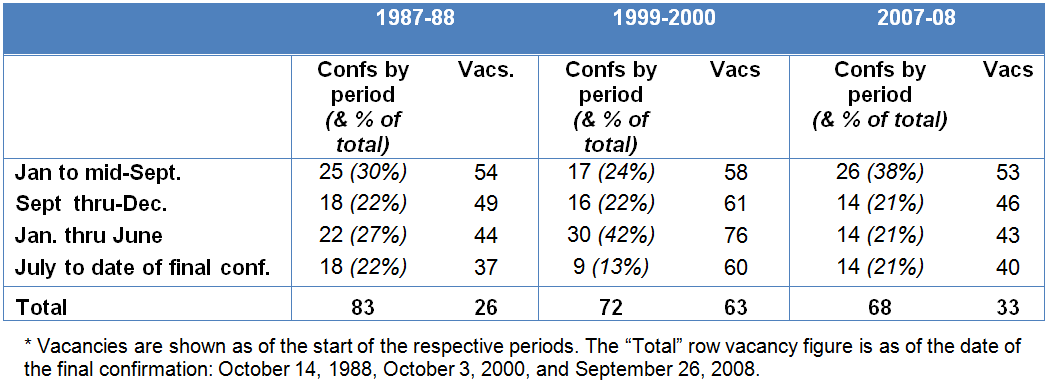
Moreover, the confirmations in the eighth years were not simply mopping up operations, confirming nominations submitted in the seventh year. As shown below, in each eighth year, the Senate confirmed over two-thirds of nominees submitted in the first half of that year and about one fourth to two fifths of those submitted after July of that year.

Anticipated invocations of the mythical “Thurmond Rule”—dictating a shutdown of nominations at some point from early to the middle of a presidential election year—will not stand up well to these data.
The Brookings Institution is committed to quality, independence, and impact.
We are supported by a diverse array of funders. In line with our values and policies, each Brookings publication represents the sole views of its author(s).
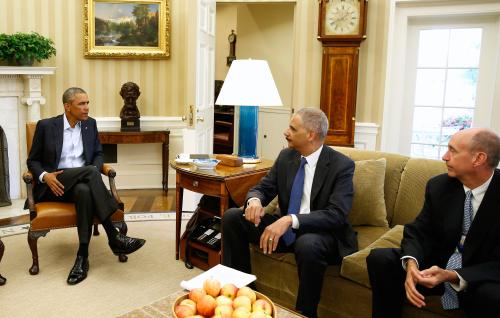

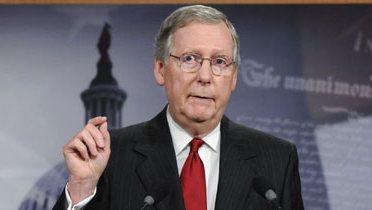


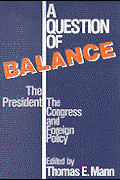
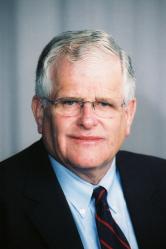
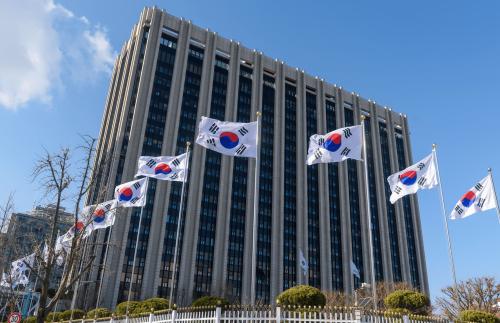


Commentary
2015-16 judicial confirmation slowdowns has little precedent in Reagan, Clinton, and Bush administrations
September 18, 2015